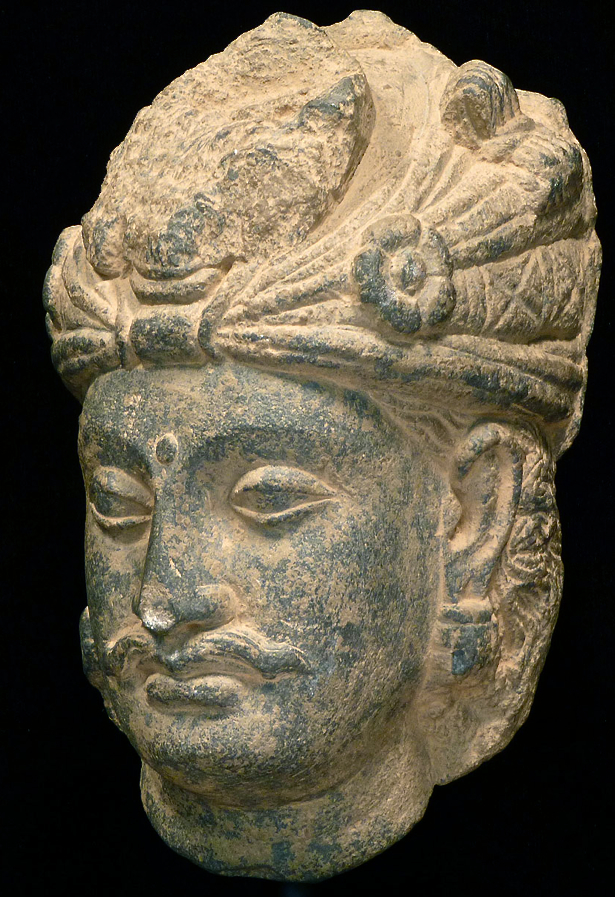

Title: Old Hand Carved Stone Rock Marble Head Of An Gandharan Prince
Shipping: $29.00
Artist: N/A
Period: Antiquity
History: N/A
Origin: Central Asia > India
Condition: Museum Quality
Item Date: 1st-2nd century AD
Item ID: 5953
FINE HEAD OF A GANDHARA PRINCE. Gandhara, 1st-2nd century AD. 7.5 x 4.5 x 4 inches. Fine quality head of a Gandharan prince with mustache and turban. Excellent condition. On custom stand. Provenance: Private New York collection acquired at auction in the 1990's. Right side. Front view. *All of the art is edited and chosen by us for its high quality and workmanship before posting. We are committed to enhancing our customer’s lives by discovering creating, and pointing out only the best art we can find in the world today. We Are Taste-Makers, Art Advisers, Consultants & Publishers Of Spectacular Art Stories. Our job is to be intermediaries between buyers and sellers. We are vetting for high end art patrons. We are determined to catalog the world's most exceptional art and share it with everyone.
Link: http://en.wikipedia.org/wiki/Greco-Buddhist_art
Greco-Buddhist art depicts the life of the Buddha in a visual manner, probably by incorporating the real-life models and concepts which were available to the artists of the period.
The Bodhisattvas are depicted as bare-chested and jewelled Indian princes, and the Buddhas as Greek kings wearing the light toga-like himation. The buildings in which they are depicted incorporate Greek style, with the ubiquitous Indo-Corinthian capitals and Greek decorative scrolls. Surrounding deities form a pantheon of Greek (Atlas, Herakles) and Indian gods (Indra).
Greco-Buddhist art is the artistic manifestation of Greco-Buddhism, a cultural syncretism between the Classical Greek culture and Buddhism, which developed over a period of close to 1000 years in Central Asia, between the conquests of Alexander the Great in the 4th century BCE, and the Islamic conquests of the 7th century CE. Greco-Buddhist art is characterized by the strong idealistic realism and sensuous description of Hellenistic art and the first representations of the Buddha in human form, which have helped define the artistic (and particularly, sculptural) canon for Buddhist art throughout the Asian continent up to the present. It is also a strong example of cultural syncretism between eastern and western traditions.
The origins of Greco-Buddhist art are to be found in the Hellenistic Greco-Bactrian kingdom (250 BCE- 130 BCE), located in today’s Afghanistan, from which Hellenistic culture radiated into the Indian subcontinent with the establishment of the Indo-Greek kingdom (180 BCE-10 BCE). Under the Indo-Greeks and then the Kushans, the interaction of Greek and Buddhist culture flourished in the area of Gandhara, in today’s northern Pakistan, before spreading further into India, influencing the art of Mathura, and then the Hindu art of the Gupta empire, which was to extend to the rest of South-East Asia. The influence of Greco-Buddhist art also spread northward towards Central Asia, strongly affecting the art of the Tarim Basin, and ultimately the arts of China, Korea, and Japan.
Powerful Hellenistic states were established in the areas of Bactria and Sogdiana, and later northern India for three centuries following the conquests of Alexander the Great around 330 BCE: the Seleucid empire until 250 BCE, followed by the Greco-Bactrian kingdom until 130 BCE, and the Indo-Greek kingdom from 180 BCE to around 10 BCE.
The clearest examples of Hellenistic art are found in the coins of the Greco-Bactrian kings of the period, such as Demetrius I of Bactria. Many coins of the Greco-Bactrian kings have been unearthed, including the largest silver and gold coins ever minted in the Hellenistic world, ranking among the best in artistic and technical sophistication: they "show a degree of individuality never matched by the often more bland descriptions of their royal contemporaries further West". ("Greece and the Hellenistic world").
These Hellenistic kingdoms established cities on the Greek model, such as in Ai-Khanoum in Bactria, displaying purely Hellenistic architectural features, Hellenistic statuary, and remains of Aristotelician papyrus prints and coin hoards.
These Greek elements penetrated in northwestern India following the invasion of the Greco-Bactrians in 180 BCE, when they established the Indo-Greek kingdom in India. Fortified Greek cities, such as Sirkap in northern Pakistan, were established. Architectural styles used Hellenistic decorative motifs such as fruit garland and scrolls. Stone palettes for aromatic oils representing purely Hellenistic themes such as a Nereid riding a Ketos sea monster are found.
As soon as the Greeks invaded India to form the Indo-Greek kingdom, a fusion of Hellenistic and Buddhist elements started to appear, encouraged by the benevolence of the Greek kings towards Buddhism. This artistic trend then developed for several centuries and seemed to flourish further during the Kushan Empire from the 1st century CE.